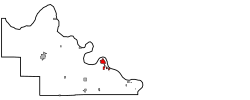Cleveland, Oklahoma
| Cleveland, Oklahoma | |
|---|---|
| City | |

Panoramic view of Cleveland in 1905, a year after the discovery of oil
|
|
| Nickname(s): Oklahoma's Pioneer Oil City | |
 Location within Pawnee County and Oklahoma |
|
| Coordinates: 36°18′23″N 96°27′53″W / 36.30639°N 96.46472°WCoordinates: 36°18′23″N 96°27′53″W / 36.30639°N 96.46472°W | |
| Country | United States |
| State | Oklahoma |
| County | Pawnee |
| Area | |
| • Total | 2.6 sq mi (6.7 km2) |
| • Land | 2.6 sq mi (6.7 km2) |
| • Water | 0.0 sq mi (0.0 km2) |
| Elevation | 778 ft (237 m) |
| Population (2009) | |
| • Total | 3,251 |
| • Density | 1,250.4/sq mi (485.2/km2) |
| Time zone | Central (CST) (UTC-6) |
| • Summer (DST) | CDT (UTC-5) |
| ZIP code | 74020 |
| Area code(s) | 539/918 |
| FIPS code | 40-15350 |
| GNIS feature ID | 1091455 |
Cleveland is a city in Pawnee County, Oklahoma. The 2010 census population was 3,251, a decrease of 0.9 percent from 3,282 at the 2000 census.
After the Cherokee Outlet opening, a homesteader by the name of Willis H. Herbert established a town named Herbert by opening a post office on the current townsite of Cleveland on October 28, 1893. The Post Office department subsequently withdrew the approval of the Herbert post office. The post office was then moved 100 feet, and reestablished under the name Cleveland, named in honor of then President Grover Cleveland on April 19, 1894. By 1900, the town's population was 211. Before the discovery of oil in the area, the town served as a trade center between the local farmers and the Osage Tribe who lived on the reservation on the other side of the Arkansas river.
In 1904, a railroad line owned by the Missouri, Kansas and Oklahoma Railroad (later known as Missouri, Kansas and Texas Railway or Katy) from Oklahoma City reached Cleveland and crossed the Arkansas River into Osage County. On May 27, 1904, the first oil well was spudded near the community, and it caused an influx of oil workers and other people. At the time of statehood in 1907, Cleveland had 1,441 residents.
According to the United States Census Bureau, the city has a total area of 2.6 square miles (6.7 km2), of which 2.6 square miles (6.7 km2) is land and 0.38% is water.
As of the census of 2000, there were 3,282 people, 1,322 households, and 913 families residing in the city. The population density was 1,264.1 people per square mile (487.4/km²). There were 1,483 housing units at an average density of 571.2 per square mile (220.2/km²). The racial makeup of the city was 85.19% White, 0.21% African American, 8.96% Native American, 0.46% Asian, 0.06% Pacific Islander, 0.34% from other races, and 4.78% from two or more races. Hispanic or Latino of any race were 1.04% of the population.
...
Wikipedia
